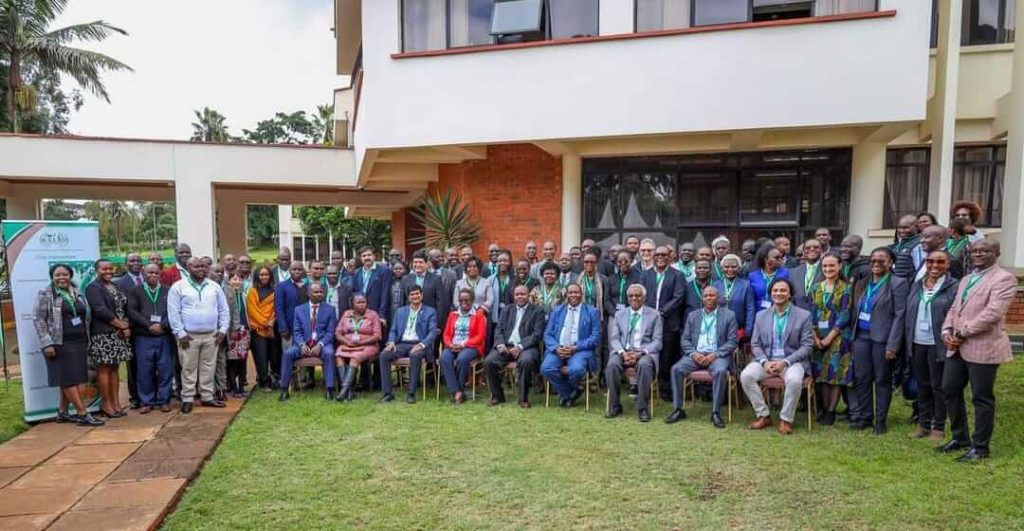Tags
Adoption Of New Rice Varieties To Increase Production

The government through the National Rice Development Strategy (NRDS) is focused on developing new rice varieties which require less water and can be planted in uplands and produce better yields.
This move is aimed at increasing 7-fold local rice production from 128,000 Metric Tonnes (MT) to 846,000 MT by the end of NRDS II in 2030. As of 2022, government statistics showed that local paddy production registered a slight increment to stand at 192, 299 MT.
State Department for Agriculture Principal Secretary (PS) Dr. Paul Ronoh said that the local demand for rice continues to increase due to rising population, urbanization, and changing food habits. The per capita consumption has risen sharply from 12 kgs in 2016 to 28 kgs in 2022 putting the demand to 1.2 million Metric Tonnes.
“Local rice production is only 20 percent of total demand with the gap sealed through imports from Asia and regional markets. The total importation bill was Sh.34.4 billion in 2022,” said the PS.
In a speech read on his behalf by the ministry’s Director for Crop Resources Management Douglas Kangi during the Kenya National Rice Conference on Thursday in Nairobi, Dr. Ronoh said that the conference seeks to address issues affecting the sub-sector which include improving access to high-yielding rice varieties, mechanization, promotion of private sector participation, climate change, employment of digital technology in the rice value chain and policy issues.
Dr. Ronoh said that various government initiatives have been undertaken to increase rice production in the country like the construction of Thiba dam in Kirinyaga County which has increased production in the Mwea irrigation scheme from 19,000 MT in 2019 to 138,000 MT in 2022.
The PS said that rice is one of the important foods in the global fight against hunger and its production is becoming important in food security and economic development in Sub-Saharan Africa.
“Kenya is among the 32 African countries implementing the Coalition for Africa Rice Development Initiative. In line with this, the first phase of the NRDS 2008-2018 was developed,” said the PS.
He added that the implementation of the second phase of the NRDS 2019-2030 is ongoing and the government is committed to increasing local rice production to a level where Kenya becomes self-sufficient.
“Kenya also participated in the development of the East African Community (EAC) Rice Development Strategy that will address issues of regional concern like research and information sharing, enhancement of policy integration, advance market competitiveness of locally produced rice as well as promotion of interregional trading among other interventions,” said Dr. Rono.
He said that in Kenya, rice is the third most important food after maize and wheat with its importance increasing both in production and productivity.
“The government continues to uphold the role of rice in reducing pressure on maize as the staple food,” said Dr. Rono.
He added that rice has been identified as a priority value chain in the government’s Bottom-up Economic Transformation Agenda (BETA) under the reduction of imports pillar.
Kenya Agricultural and Livestock Research Organisation (KALRO) Director General Dr. Eliud Kireger said that one of their strategic objectives is to improve crop production, productivity, and utilization.
“Various strides have been made in the rice research including release, dissemination and commercialization of irrigated and rain-fed lowland Komboka rice and five upland rice varieties namely NERICA1, NERICA4, NERICA10, NERICA11, and Duorado precoce; validation and dissemination of improved crop management practices in farmers’ fields; strengthening the rice seed system to the current annual production of over 80MT of certified rice seed; and licensing over five seed merchants to produce certified seed for commercial production,” said Dr. Kireger.
In a speech read on his behalf by the Director KALRO seeds, Robert Musyoki, Dr. Kireger said that these achievements have been realized through public-private partnerships.
In this regard, KALRO and The International Rice Research Institute (IRRI) have since 2012 collaborated to implement in-country rice research and development initiatives.
“This collaboration has not only led to the breeding of new varieties for lowland rice ecologies but also in the development of market segments and product profiles to guide rice improvement in the country,” said Dr. Kireger.
https://www.kenyanews.go.ke/adoption-of-new-rice-varieties-to-increase-production/Published Date: November 18, 2023





